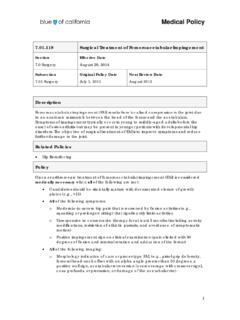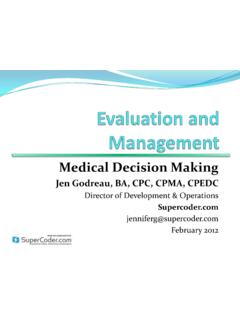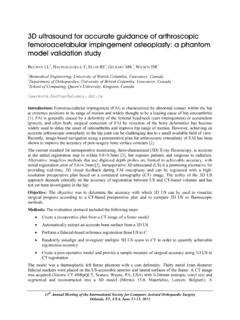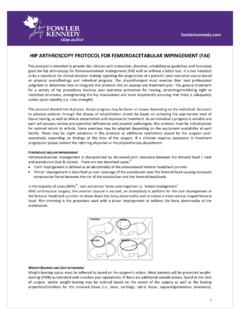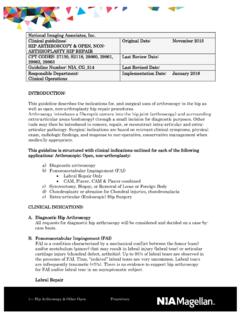Transcription of Surgical Treatment of Femoroacetabular Impingement
1 Page 1 of 21 Proprietary Information of Blue Cross and Blue Shield of Alabama Medical Policy #421 Name of Policy: Surgical Treatment of Femoroacetabular Impingement Policy #: 421 Latest Review Date: June 2014 Category: Surgery Policy Grade: B Background/Definitions: As a general rule, benefits are payable under Blue Cross and Blue Shield of Alabama health plans only in cases of medical necessity and only if services or supplies are not investigational, provided the customer group contracts have such coverage. The following Association Technology Evaluation Criteria must be met for a service/supply to be considered for coverage: 1. The technology must have final approval from the appropriate government regulatory bodies; 2. The scientific evidence must permit conclusions concerning the effect of the technology on health outcomes; 3.
2 The technology must improve the net health outcome; 4. The technology must be as beneficial as any established alternatives; 5. The improvement must be attainable outside the investigational setting. Medical Necessity means that health care services ( , procedures, treatments, supplies, devices, equipment, facilities or drugs) that a physician, exercising prudent clinical judgment, would provide to a patient for the purpose of preventing, evaluating, diagnosing or treating an illness, injury or disease or its symptoms, and that are: 1. In accordance with generally accepted standards of medical practice; and 2. Clinically appropriate in terms of type, frequency, extent, site and duration and considered effective for the patient s illness, injury or disease; and 3. Not primarily for the convenience of the patient, physician or other health care provider; and 4.
3 Not more costly than an alternative service or sequence of services at least as likely to produce equivalent therapeutic or diagnostic results as to the diagnosis or Treatment of that patient s illness, injury or disease. Page 2 of 21 Proprietary Information of Blue Cross and Blue Shield of Alabama Medical Policy #421 Description of Procedure or Service: Femoroacetabular Impingement (FAI) results from localized compression in the joint due to an anatomical mismatch between the head of the femur and the acetabulum. Symptoms of Impingement typically occur in young to middle-aged adults prior to the onset of osteoarthritis, but may be present in younger patients with developmental hip disorders. The objective of Surgical Treatment of FAI is to improve symptoms and reduce further damage to the joint.
4 FAI arises from an anatomical mismatch between the head of the femur and the acetabulum, causing compression of the labrum or articular cartilage during flexion. The mismatch can arise from subtle morphologic alterations in the anatomy or orientation of the ball-and-socket components (for example, a bony prominence at the head-neck junction or acetabular over-coverage) with articular cartilage damage initially occurring from abutment of the femoral neck against the acetabular rim, typically at the anterosuperior aspect of the acetabulum. Although hip joints can possess the morphologic features of FAI without symptoms, FAI may become pathologic with repetitive movement and/or increased force on the hip joint. High-demand activities may also result in pathologic Impingement in hips with normal morphology.
5 Two types of Impingement , known as cam Impingement and pincer Impingement may occur alone or more frequently together. Cam Impingement is associated with an asymmetric or nonspherical contour of the head or neck of the femur jamming against the acetabulum, resulting in cartilage damage and delamination (detachment from the subchondral bone). Deformity of the head/neck junction that looks like a pistol grip on radiographs is associated with damage to the anterosuperior area of the acetabulum. Symptomatic cam Impingement is found most frequently in young male athletes. Pincer Impingement is associated with over-coverage of the acetabulum and pinching of the labrum, with pain more typically beginning in women of middle age. In cases of isolated pincer Impingement , the damage may be limited to a narrow strip of the acetabular cartilage.
6 It has been proposed that Impingement with damage to the labrum and/or acetabulum is a causative factor in the development of hip osteoarthritis, and that as many as half of cases currently categorized as primary osteoarthritis may have an etiology of FAI. Previously, access to the joint space was limited and Treatment consisted primarily of debridement and/or labral reattachment. A technique for hip dislocation with open osteochondroplasty that preserved the femoral blood supply was reported by Ganz et al in 2001. Visualization of the entire joint with this procedure lead to the identification and acceptance of FAI as an etiology of cartilage damage (the association between abnormal femoral head/neck morphology and early-age-onset osteoarthritis had been described earlier by others) and the and the possibility of correcting the abnormal Femoroacetabular morphology.
7 Open osteochondroplasty of bone abnormalities and Treatment of the symptomatic cartilage defect is considered the gold standard for complex bony abnormalities. However, open osteochondroplasty is invasive, requiring transection of the greater trochanter (separation of the femoral head from the femoral shaft) and dislocation of the hip joint to provide full access to the femoral head and acetabulum. In addition to the general adverse effects of open Surgical procedures, open osteochondroplasty with dislocation has been associated with non-union, and neurologic and soft tissue lesion. Less invasive hip arthroscopy and an arthroscopy-assisted mini-approach were adapted from the open approach by 2004. Arthroscopy requires specially designed instruments and is considered to be more technically difficult due to reduced visibility Page 3 of 21 Proprietary Information of Blue Cross and Blue Shield of Alabama Medical Policy #421 and limited access to the joint space.
8 Advanced imaging techniques, including computed tomography and fluoroscopy, have been utilized to improve visualization of the 3-dimensional head/neck morphology during arthroscopy. An association between FAI and athletic pubalgia, sometimes called sports hernia, has been proposed. Athletic pubalgia is an umbrella term for a large variety of musculoskeletal injuries involving attachments and/or soft tissue support structures of the pubis. It is believed that if FAI presents with limitations in hip range of motion, compensatory patterns during athletic activity may lead to increased stresses involving the abdominal obliques, distal rectus abdominis, pubic symphysis, and adductor musculature. The condition is more common in men than in women, and is associated with sports in which high speed twisting of the hip and pelvis occur ( , football and hockey).
9 Under Surgical exploration, a variety of musculotendinous defects, nerve entrapments, and inflammatory conditions have been observed. These defects are often discovered and repaired during open or minimally invasive exploratory laparoscopy. Surgery for athletic pubalgia has been performed concurrently with Treatment of FAI, or might be performed following FAI surgery if symptoms do not resolve. The recognition and Treatment of FAI has also brought attention to the possibility of can-type FAI after slipped capital femoral epiphysis (SCFE). The standard Treatment for SCFE is stabilization across the physis by in-situ pinning, although it is not uncommon for patients with SCFE to develop premature patients with SCFE-related FAI include osteoplasty without dislocation, or with the open dislocation technique describe by Ganz.
10 The Ganz technique (capital realignment with open dislocation) is technically demanding with a steep learning curve and a high risk of complications. Therefore, early Treatment to decrease Impingement must be weighed against increased risk for adverse events including avascular necrosis in patients with SCFE. It is known that Surgical Treatment of FAI pathology is less effective for pain reduction in patients with late stage osteoarthritis. In addition, delay in the Surgical correction of bony abnormalities may lead to disease progression to the point where joint preservation is no longer appropriate. It is believed that osteoplasty of the impinging bone is needed to protect the cartilage from further damage and preserve the natural joint. Therefore, if FAI morphology is shown to be an etiology of osteoarthritis, a future strategy to reduce the occurrence of idiopathic hip osteoarthritis could be early recognition and Treatment of FAI before cartilage damage occurs.
